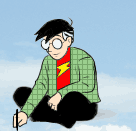
What’s the default shape of our art forms?
Cinema is wider than it is tall. TV is wider than it is tall. Theater is wider than it is tall. Laptop and desktop monitors are wider than they are tall. In fact, with the advent of widescreen TVs, there’s little difference in the shapes. They’re all around 3×5 or 4×5 range. Wider than tall. All of them.
And print? Well, print is taller than it is wide right? The printed page is the exception to the rule, isn’t it?
Wrong.
The default shape of print is not taller than wide. It’s wider than tall just like all the rest, because the default shape of print is two pages side-by-side. And the reason is the same reason as the shape of TV and cinema and theater and surfing and all the rest: because we have two eyes next to each other, not one on top of the other.
I don’t even have a Kindle yet, so this isn’t meant as a specific critique of the device. And I’m sure its engineers had solid practical reasons to design the device the way they did. You can even turn it sideways when needed. It just reminded me when I went to Amazon this morning and saw images of the latest, how design principles in the wild can always be adjusted on the fly, but as soon as they’re embedded in hardware, they tend to stick around. For decades in some cases.
So if I could humbly suggest a new cardinal rule of designing anything meant to be read (including webcomics): Step #1, look in a mirror.
[Edit to add: Within ten minutes of posting, everybody has agreed that I’m utterly wrong about this! Oh well. Check the comments thread to see some smart, funny rebuttals.]















